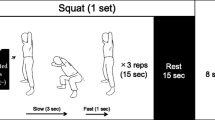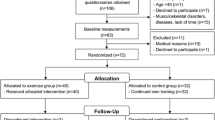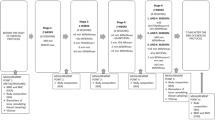Abstract
The aim of the present study was to evaluate the effects of a 16-week progressive high-intensity strength training (HIST) program on peripheral markers of bone turnover (bone Gla protein, BGP; bone alkaline phosphatase, B-AP; N-terminal propeptide of type I procollagen, PINP; C-terminal cross-linked telopeptide of type I collagen, ICTP) in healthy, elderly men over 65 yr of age. Thirty healthy men (aged 65–81 yr), performing light to moderate daily physical activity, were randomly divided into two groups. Group 1 (no.=16) followed a supervised 16-week progressive HIST program, while subjects of group 2 (no.=14), used as controls, were requested to maintain their habitual level of physical activity for 16 weeks. HIST program consisted of 6 different sets of exercise (2 involving the major muscle groups of the lower limb and 4 involving those of the upper limb). Three sessions/week, during which 10 repetitions of each exercise set were completed, were performed. Lower limb exercises shifted from 50 to 80% of the one maximal repetition (1MR) during the first month of the protocol and were thereafter maintained at an intensity of 80% 1MR throughout the training. Upper limb exercises shifted from 40 to 65% of 1MR with a similar pattern. All sessions were preceded by 15 min of cycloergometer exercise at 50% of maximal oxygen uptake and by a warm-up of 15 repetitions at 20% of 1MR of each exercise set. The HIST program did not significantly change BGP (mean±SE, before: 15.6±1.2 μg/l vs after: 16.0±1.2 μg/l, NS) and PINP levels (before: 44.6±6.7 μg/l vs after: 43.1±6.0 μg/l, NS). On the contrary, serum B-AP significantly increased (before: 50.2±6.1 IU/l vs after: 62.3±7.0 IU/l, p<0.001) and serum ICTP slightly reduced (before: 4.0±0.3 μg/l vs after: 3.8±0.3 μg/l, p<0.05). When bone turnover was expressed as the ratio between bone formation to bone resorption (B-AP/ICTP ratio), a significant improvement in this ratio was found in all subjects of group 1 (before: 12.9±1.3 IU/μg vs after: 17.3±1.5 IU/μg, p<0.0001), while no significant changes were observed in Group 2. No significant changes of IGF-I levels were observed after the HIST program (before: 94.9±9.4 μg/l vs after: 89.9±9.7 μg/l). No significant changes of BGP, PINP, B-AP, ICTP, B-APICTP ratio and IGF-I levels were observed in controls (group 2) during the 16 weeks of observation. Although the positive effects of a progressive HIST program on B-AP levels and B-AP-ICTP ratio seem promising, the support of bone mass measurement and the determination of other bone markers are requested to better identify exercise protocol (duration, intensity) for elderly people.
Similar content being viewed by others
References
Wolff I., van Croonenborg J.J., Kemper H.C., Kostense P.J., Twisk J.W. The effect of exercise training programs on bone mass: a meta-analysis of published controlled trials in pre- and postmenopausal women. Osteoporos. Int. 1999, 9: 1–12.
Smith E.L., Gilligan C. Physical activity effects on bone metabolism. Calcif. Tissue Int. 1991, 49 (Suppl.): S50–S54.
Gutin B., Kasper M.J. Can vigorous exercise play a role in osteoporosis prevention? A review. Osteoporos. Int. 1992, 2: 55–69.
Forwood M.R., Burr D.B. Physical activity and bone mass: exercises in futility? Bone Miner. 1993, 21: 89–112.
Chilibeck P.D., Sale D.G., Webber C.E. Exercise and bone mineral density. Sports Med. 1995, 19: 103–122.
Mosekilde L. Osteoporosis and exercise. Bone 1995, 17: 193–195.
Sinaki M. Exercise and osteoporosis. Arch. Phys. Med. Rehabil. 1989, 70: 220–229.
Welsh L., Rutherford O.M. Hip bone mineral density is improved by high-impact aerobic exercise in postmenopausal women and men over 50 years. Eur. J. Appl. Physiol. 1996, 74: 511–517.
Hurley B.F., Hagberg J.M. Optimizing health in older persons: aerobic or strength training? Exerc. Sport Sci. Rev. 1998, 26: 61–89.
Risteli L., Risteli J. Biochemical markers of bone metabolism. Ann. Med. 1993, 25: 385–393.
Watts N.B. Clinical utility of biochemical markers of bone remodeling. Clin. Chem. 1999, 45: 1359–1368.
Rosalki S.B., Foo A.Y. Two new methods for separating and quantifying bone and liver alkaline phosphatase isoenzymes in plasma. Clin. Chem. 1984, 30: 1182–1185.
Block J.E., Friedlander A.L., Brooks G.A., Steiger P., Stubbs H.A., Genant H.K. Determinants of bone density among athletes engaged in weight-bearing and non-weight-bearing activity. J. Appl. Physiol. 1989, 67: 1110–1115.
Colletti L.A., Edwards J., Gordon L., Shary J., Bell N.H. The effects of muscle-building exercise on bone mineral density of the radius, spine, and hip in young men. Calcif. Tissue Int. 1989, 45: 12–14.
Menkes A., Mazel S., Redmond R.A., Koffler K., Libanati C.R., Gundberg C.M., Zizzic T.M., Hagberg J.M., Pratley R.E., Hurley B.F. Strength training exercise increases regional bone mineral density and bone remodeling in middle-aged and older men. J. Appl. Physiol. 1993, 74: 2478–2484.
Ryan A.S., Treuth M.S., Rubin M.A., Miller J.P., Nicklas B.J., Landis D.M., Pratley R.E., Libanati C.R., Gundberg C.M., Hurley B.F. Effects of strength training on bone mineral density: hormonal and bone turnover relationships. J. Appl. Physiol. 1994, 77: 1678–1684.
Heinonen A., Oja P., Sievänen H., Pasanen M., Vuori I. Effect of two training regimens on bone mineral density in healthy perimenopausal women: a randomized controlled trial. J. Bone Miner. Res. 1998, 13: 483–490.
Zerath E., Holy X., Douce P., Guezennec C.Y., Chatard J.C. Effect of endurance training on postexercise parathyroid hormone levels in elderly men. Med. Sci. Sports Exerc. 1997, 29: 1139–1145.
Yarasheski K.E., Campbell J.A., Kohrt W.M. Effect of resistance exercise and growth hormone on bone density in older men. Clin. Endocrinol. (Oxf.) 1997, 47: 223–229.
Author information
Authors and Affiliations
Corresponding author
Additional information
Partially supported by Progetti di Ricerca Corrente (grant n° 05C906), Istituto Auxologico Italiano, IRCCS, Milan, Italy.
Rights and permissions
About this article
Cite this article
Sartorio, A., Lafortuna, C., Capodaglio, P. et al. Effects of a 16-week progressive high-intensity strength training (HIST) on indexes of bone turnover in men over 65 years: A randomized controlled study. J Endocrinol Invest 24, 882–886 (2001). https://doi.org/10.1007/BF03343946
Accepted:
Published:
Issue Date:
DOI: https://doi.org/10.1007/BF03343946




